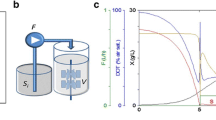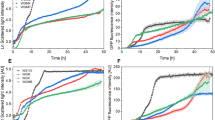Abstract
Various fermentation strategies in industrial biotechnology are applied to produce recombinant target proteins using Escherichia coli. These proteins are often expressed as inclusion bodies (IBs), resulting in a high purity, high stability, and high product titers. In state-of-the-art fed-batch processes, product formation takes place in a short period of time. Sterilization, cleaning, and biomass growth are time consuming steps and reduce the space-time yield. Thus, the interest in establishing continuous cultivations, facilitating higher space-time yields, has been increased in recent years. In this protocol, we provide information and a guide to set-up the production of recombinant proteins in fed-batch, as well as in chemostat continuous cultivations using E. coli.
Access this chapter
Tax calculation will be finalised at checkout
Purchases are for personal use only
Similar content being viewed by others
References
Demain AL, Vaishnav P (2009) Production of recombinant proteins by microbes and higher organisms. Biotechnol Adv 27(3):297–306
Walsh G (2010) Post-translational modifications of protein biopharmaceuticals. Drug Discov Today 15(17):773–780
Manta B et al (2019) Disulfide bond formation in the periplasm of Escherichia coli. EcoSal Plus 8(2)
Missiakas D, Raina S (1997) Protein folding in the bacterial periplasm. J Bacteriol 179(8):2465–2471
Wurm DJ et al (2017) Mechanistic platform knowledge of concomitant sugar uptake in Escherichia coli BL21(DE3) strains. Sci Rep 7:45072–45072
Kopp J et al (2017) Impact of glycerol as carbon source onto specific sugar and inducer uptake rates and inclusion body productivity in E. coli BL21(DE3). Bioengineering (Basel, Switzerland) 5(1):1
Rosano GA-O, Morales ES, Ceccarelli EA-O. New tools for recombinant protein production in Escherichia coli: A 5-year update. (1469-896X (Electronic))
Kopp J et al (2020) Repetitive fed-batch: a promising process mode for biomanufacturing with E. coli. Front Bioeng Biotechnol 8:1312
Singh A et al (2015) Protein recovery from inclusion bodies of Escherichia coli using mild solubilization process. Microb Cell Factories 14(1):41
Carrió MM, Villaverde A (2005) Localization of chaperones DnaK and GroEL in bacterial inclusion bodies. J Bacteriol 187(10):3599–3601
García-Fruitós E (2010) Inclusion bodies: a new concept. Microb Cell Factories 9(1):80
Slouka CA-OX et al. Perspectives of inclusion bodies for bio-based products: curse or blessing? (1432–0614 (Electronic))
Kittler S et al (2021) Cascaded processing enables continuous upstream processing with E. coli BL21(DE3). Sci Rep 11(1):11477
Adamberg K, Valgepea K, Vilu R (2015) Advanced continuous cultivation methods for systems microbiology. Microbiology 161(9):1707–1719
Peebo, K. and P. Neubauer, Application of continuous culture methods to recombinant protein production in microorganisms. Microorganisms, 2018. 6(3): p. 56
Kopp J et al. The Rocky Road from Fed-Batch to Continuous Processing with E. coli. (2296–4185 (Print))
Lee S et al (2015) Modernizing pharmaceutical manufacturing: from batch to continuous production. J Pharm Innov 10:191–199
Curvers S et al. Human chymotrypsinogen B production with Pichia pastoris by integrated development of fermentation and downstream processing. Part 1. Fermentation. (8756–7938 (Print))
Wurm DJ et al (2016) The E. coli pET expression system revisited-mechanistic correlation between glucose and lactose uptake. Appl Microbiol Biotechnol 100(20):8721–8729
Neubauer P et al (1992) Maximizing the expression of a recombinant gene in Escherichia coli by manipulation of induction time using lactose as inducer. Appl Microbiol Biotechnol 36(6):739–744
Deutscher J, Francke C, Postma PW (2006) How phosphotransferase system-related protein phosphorylation regulates carbohydrate metabolism in bacteria. Microbiol Mol Biol Rev 70(4):939–1031
Postma PW, Lengeler JW, Jacobson GR (1993) Phosphoenolpyruvate: carbohydrate phosphotransferase systems of bacteria. Microbiol Rev 57(3):543–594
Lin E (1976) Glycerol dissimilation and its regulation in bacteria. Annu Rev Microbiol 30(1):535–578
Zwaig N, Kistler W, Lin E (1970) Glycerol kinase, the pacemaker for the dissimilation of glycerol in Escherichia coli. J Bacteriol 102(3):753–759
Voegele RT, Sweet GD, Boos W (1993) Glycerol kinase of Escherichia coli is activated by interaction with the glycerol facilitator. J Bacteriol 175(4):1087–1094
Swords WE. Chemical transformation of E. coli. (1064–3745 (Print))
Tomley FM. Transformation of E. coli. (1064–3745 (Print))
DeLisa MP et al (1999) Monitoring GFP-operon fusion protein expression during high cell density cultivation of Escherichia coli using an on-line optical sensor. Biotechnol Bioeng 65(1):54–64
Kopp J et al (2020) Development of a generic reversed-phase liquid chromatography method for protein quantification using analytical quality-by-design principles. J Pharm Biomed Anal 188:113412
Author information
Authors and Affiliations
Corresponding author
Editor information
Editors and Affiliations
Rights and permissions
Copyright information
© 2023 The Author(s), under exclusive license to Springer Science+Business Media, LLC, part of Springer Nature
About this protocol
Cite this protocol
Kittler, S. (2023). Inclusion Body Production in Fed-Batch and Continuous Cultivation. In: Kopp, J., Spadiut, O. (eds) Inclusion Bodies. Methods in Molecular Biology, vol 2617. Humana, New York, NY. https://doi.org/10.1007/978-1-0716-2930-7_6
Download citation
DOI: https://doi.org/10.1007/978-1-0716-2930-7_6
Published:
Publisher Name: Humana, New York, NY
Print ISBN: 978-1-0716-2929-1
Online ISBN: 978-1-0716-2930-7
eBook Packages: Springer Protocols




